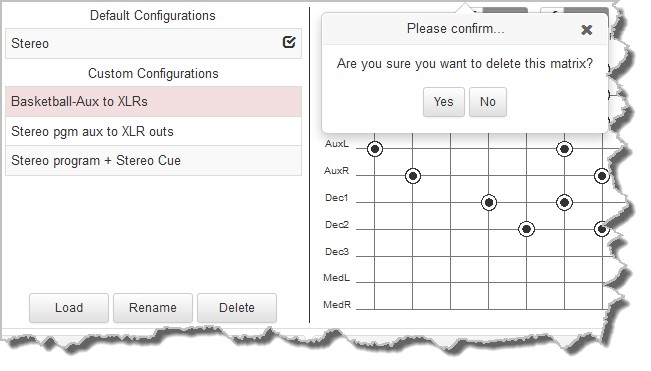
The matrix editor in the codec allows any input to be routed to any output. Default routing settings are configured for each program type and these default matrices can be edited, saved and recalled as required. All saved custom matrices are available if a compatible program is loaded. If a matrix is not compatible with a program type it will not be visible in the menu, e.g. a saved stereo matrix is not visible when a mono program is loaded.
Custom matrices can be created and saved and then backed up with program and scheduler data. This allows them to be copied between codecs by using the Backup and Restore feature.
|
Important Notes: •If you create custom headphone mixes, save them, and then save the overall mix in the Matrix Editor, all the custom headphone mixes and their Send/Return balance settings are also saved along with other codec routing settings. •Only crosspoint routing settings for XLR and Digital Outputs are stored in a custom matrix. The send/return balance, ganging, output mute and output level settings are not saved. |
Viewing the Matrix Editor
Open the HTML5 Toolbox Web-GUI and click Audio in the Menu Bar, then click Matrix Editor to open the Matrix Editor panel. In the following image the default stereo matrix is loaded, as indicated by the Stereo check-box in the left-hand pane in the panel. Custom matrix configurations are also listed in the left-hand pane.
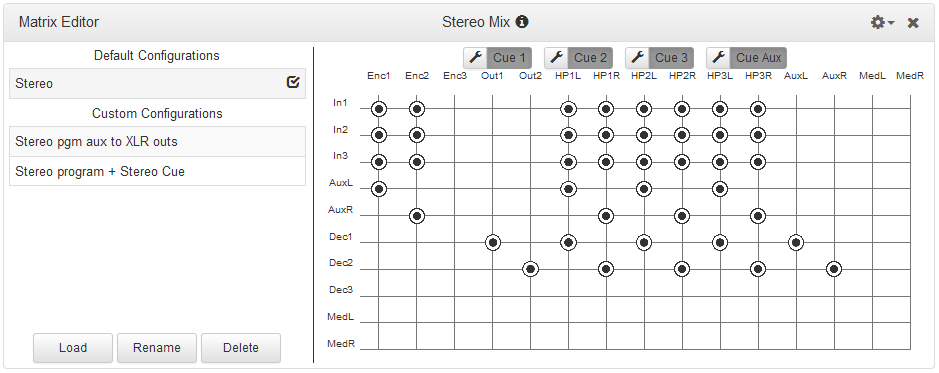
Click the Options symbol  to view other matrix editor options, including:
to view other matrix editor options, including:
1.Undo Changes: Clears any changes that have not been saved.
2.Reset Defaults: Resets the matrix to defaults for the currently loaded program, e.g. mono, stereo, mono/stereo plus IFB.
3.Save as: Save the current matrix settings as a new Custom Mix with a unique name (includes headphone and Cue/TB matrices).
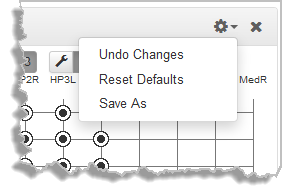
View Cue and Talkback Matrices
Click the Cue/Talkback 1-3 buttons at the top of the Matrix Editor to view Cue/Talkback routing in red.
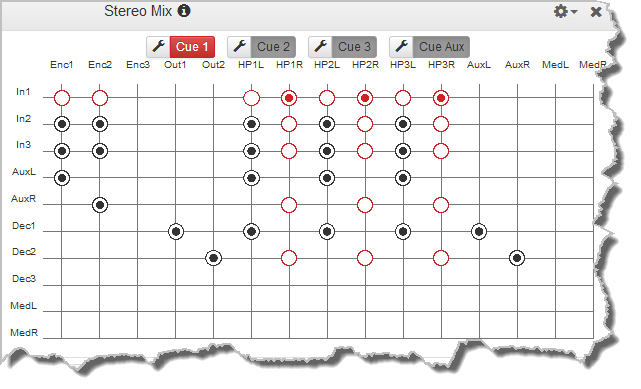
Using the Matrix Editor
Routing can be adjusted very simply in the matrix editor. To edit default matrix settings click a crosspoint to select or deselect it. Routing edits are also reflected automatically in:
1.The Headphone mix visible in the Headphones panel.
2.The XLR Outputs and Digital Outputs accessed via HOME ![]() > Audio
> Audio  > XLR Outputs
> XLR Outputs  / Digital Outputs
/ Digital Outputs  on the codec TOUCH SCREEN.
on the codec TOUCH SCREEN.
In the following example, the auxiliary input (AuxL and AuxR) have been deselected from the encoder outputs (Enc1 and Enc2) and have instead been routed to the analog XLR outputs (Out1 and Out2). Note: Changes not yet saved as a custom mix are displayed in orange. Runtime changes are audible in real-time and persist if the unit is powered down and rebooted.
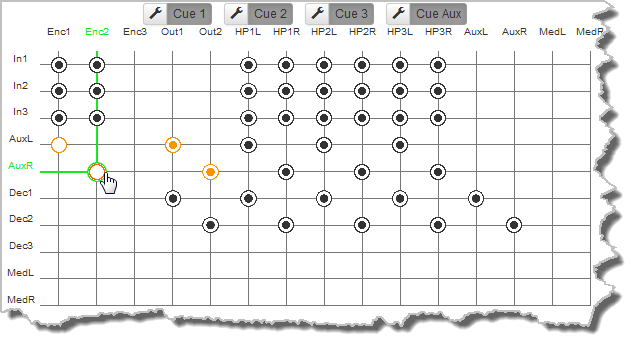
Edits can be saved as a custom mix, which also includes any edits to Headphone, XLR Output, Digital Output or Cue/TB Mix matrices. To save a custom mix:
1.Click the Options symbol  and select Save As.
and select Save As.
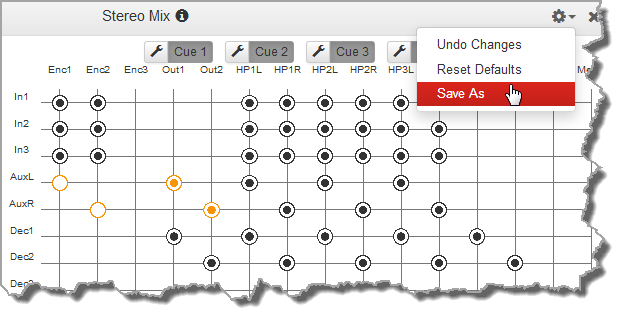
2.Enter a new Name and Description (if required) and click Save.
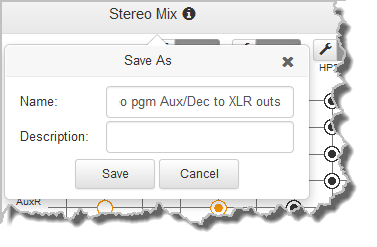
3.The new custom mix stays loaded in the codec until a new mix is loaded, an incompatible program is loaded, or program defaults are restored via Reset Defaults.
|
Important Notes: •If a new program is loaded and it is compatible with the current custom mix then it will remain loaded. If an incompatible program type is loaded, the last compatible mix to suit the new program type is loaded, including any runtime changes made previously. E.g. If a custom stereo mix is loaded and then a mono program is loaded, the last mono mix used will be loaded. •If you make runtime matrix edits to a loaded mono program, then load a stereo program, and subsequently reload the original mono program, the runtime matrix edits are recalled. |
Editing Cue and Talkback Matrices
Typically, local cue intercom is configured for commentators to talk to each other offline. In cue mode, offline communications audio from inputs 1-3 is routed to the right side of all local headphone outputs (HP 1-3) when the TB CUE button is pressed. By default this is the same for:
•Mono Peer-to-Peer programs.
•Stereo Peer-to-Peer programs.
•2 x Mono Peer-to-Peer programs.
When you load a Mono Peer-to-Peer + IFB program, or a Stereo Peer-to-Peer + IFB program, two independent audio streams are configured to stream program and communications audio separately. When an announcer presses an input's TB CUE button, audio is routed to the IFB audio stream encoder and outgoing audio is simultaneously monitored in the right side of the selected input's headphone output. Return IFB audio is also audible in the right side of the headphones.
1.Click the Cue/Talkback 1-3 buttons at the top of the Matrix Editor to view current routing.
2.Click a crosspoint to select or deselect an audio crosspoint. Note: Changes not yet saved as a custom mix are displayed in orange. Runtime changes are audible in real-time and persist if the unit is powered down and rebooted.
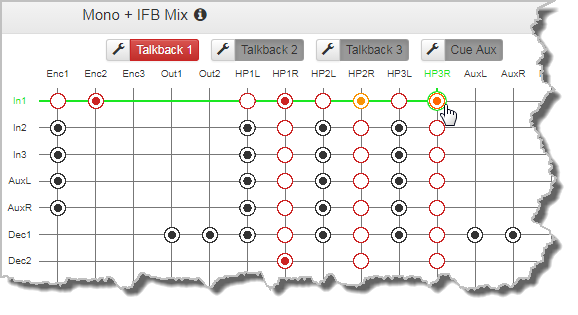
To learn more about the differences between cue and talkback functions, and editing cue and talkback matrices with the TOUCH SCREEN, see Cue and Talkback Operation.
Load, Rename and Delete a Custom Matrix Editor Mix
When a new program is loaded it may be necessary to load a new custom mix. It is also possible to rename or delete mixes that are no longer required.
1.To load a custom mix click to select a mix listed under Custom Configurations in the left-hand pane, then click Load.
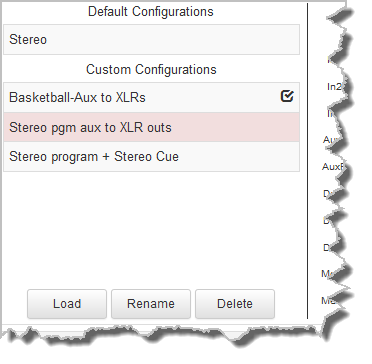
2.To rename a custom mix, click to select a saved mix and then click Rename.
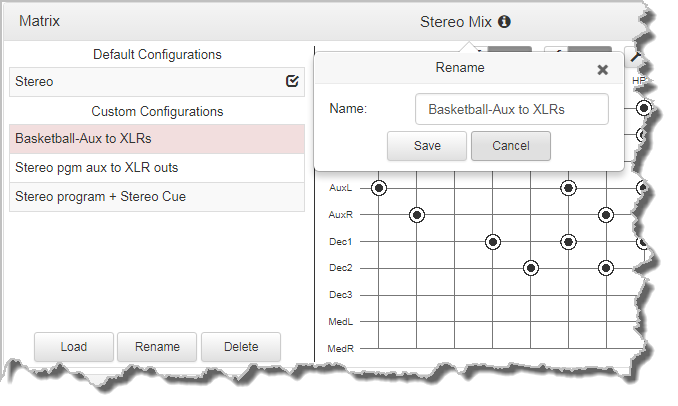
3.To delete a custom mix, click to select a custom mix and then click Delete. Note: A mix cannot be deleted if it is currently loaded.
